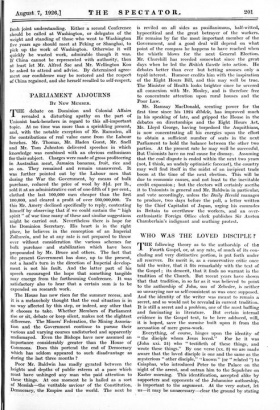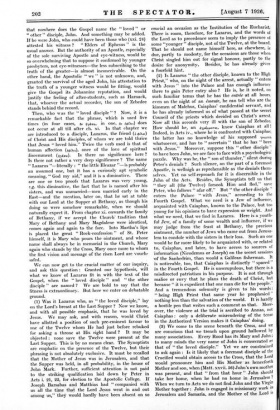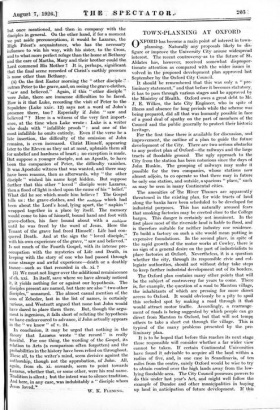WHO WAS THE LOVED DISCIPLE '
THE following theory as to the authorship of the Fourth Gospel, or, at any rate, of much of its con- cluding and very distinctive portion, is put forth under all reserves. Its merit is, as a conservative critic once told the writer, that it fits remarkably with the text of the Gospel ; its demerit, that it finds no warrant in the 'tradition of the Church. But recent years have shown that that tradition, in so far as it was believed to point "to the authorship of John, son of Zebedee, is neither so unvarying nor so self-consistent as was once supposed. And the identity of the writer was meant to remain a secret, and so would not be revealed in current tradition. It is still a secret and a problem, one of the most baffling and fascinating in literature. But certain internal evidence in the Gospel text, to be here adduced, will, it is hoped, save the surmise built upon it from the accusation of mere guess-work.
Everything, of course, hinges upon the identity of " the disciple whom Jesus loved." For he it was (John xxi. 24) who " testifieth of these things, and wrote these things." By one verse (xx. 8) we are made aware that the loved disciple is one and the same as the mysterious " other disciple," " known " (or " related ") to Caiaphas, who introduced Peter to the Palace on the night of the arrest, and outran him to the Sepulchre on Easter morning. This identification, accepted alike by supporters and opponents of the Johannine authorship, - is important to the argument. At the very outset, let us—it may be unnecessary—clear the ground by stating that nowhere does the Gospel name the " loved " or " other " disciple, John. And something may be added. If he were John, who could have been those who (xxi. 24) attested his witness ? " Elders of Ephesus " is the usual answer. But the authority of an Apostle, especially of the sole surviving Apostle and eye-witness, would be so overwhelming that to suppose it confirmed by younger presbyters, not eye-witnesses—the less subscribing to the truth of the greater—is almost inconceivable. On the other hand, the Apostolic " we " is not unknown, and, granted the survival of the aged John, his attestation to the truth of a younger witness would be fitting, would give the Gospel its Johannine reputation, and would justify the feeling of after-students, such as Harnack, that, whoever the actual recorder, the son of Zebedee stands behind the record.
Then, who was the " loved disciple " ? Now, it is a remarkable fact that the phrase, which is used five times (in four cases, ay *yarn, in one, su gorxe.) does not occur at all till after ch. xi. In that chapter we are introduced to a disciple, Lazarus, the friend (.5.(xos) of Christ and His disciples, of whom we are told thrice that Jesus " loved him." Twice the verb used is that of human affection NAG), once of the love of spiritual discernment (grydr.). Is there no significance here ? Is there not rather a very deep significance ? The name " Lazarus "—literally : " the little Eleazar "—is probably an assumed one, but it has a curiously apt symbolic meaning, " God my aid," and it is a diminutive. There are one or two proofs that Lazarus was very young, e.g. this diminutive, the fact that he is named after his sisters, and was unmarried—men married early in the East—and the mention, later on, that he sat at table with our Lord at the Supper at Bethany, as though his doing so were somehow remarkable, when we should naturally expect it. From chapter xi. onwards the family of Bethany, if we accept the Church' tradition that Mary of Bethany and Mary Magdalene were identical, comes again and again to the fore. Into Martha's lips is placed the great " Rock-confession " of St. Peter himself, it is Mary who pours the ointment, and whose name shall always be in memorial in the Church, Mary again who stands by the Cross, Mary once more to whom the first vision and message of the risen Lord are vouch- safed.
We can now get to the crucial matter of our inquiry, and ask this question : Granted our hypothesis, will what we know of Lazarus fit in with the text of the Gospel, when the " loved disciple " and " the other disciple " are named ? We are bold to say that the fitness is extraordinary. But here we enter on debatable ground.
(1) Was it Lazarus who, as " the loved disciple," lay on the Lord's breast at the Last Supper ? Now we know, and with all possible emphasis, that he was loved by Jesus. We may ask, and with reason, would Christ have allotted a position of such pre-eminent favour to one of the Twelve whom He had just before rebuked for asking a throne at His right hand ? It may be objected : none save the Twelve were present at the Last Supper. This is by no means clear. The Synoptists are emphatic on the presence of the Twelve, but their phrasing is not absolutely exclusive. It must be recalled that the Mother of Jesus was in Jerusalem, and that the Supper was held, in all probability, in the house of John Mark. Further, sufficient attention is not paid to the striking qualification laid down by Peter in Acts i. 21, 22, for election to the Apostolic College. If Joseph Barsabas and Matthias had " companied with us all the time that the Lord Jesus went in and out among us," they would hardly have been absent on so crucial an occasion as the Institution of the Eucharist. There is room, therefore, for Lazarus, and the words of the Lord as to precedence seem to imply the presence of some "younger " disciple, not of the Twelve, at the board. That he should not name himself here, as elsewhere, is due, partly to modesty, for the occasions are those when Christ singled him out for signal honour, partly to the desire for anonymity. Besides, he has already given a fourfold hint.
(2) Is Lazarus " the other disciple, known to the High Priest," who, on the night of the arrest, actually " enters with Jesus " into the Palace and has enough influence there to gain Peter entry also ? He is, be it noted, on such familiar terms that he has the entrée at all hours, even on the night of an emeute, he can tell who are the kinsmen of Malchus, Caiaphas' confidential servant, and he has already informed us of what passed at the secret Council of the priests which decided on Christ's arrest. Now all this accords very ill with the son of Zebedee. How should he, an ttypdpA.,, know Caiaphas at all Indeed, in Acts iv., where he is confronted with Caiaphas, the latter has no knowledge of his supposed -ypeemn whatsoever, and has to " ascertain " that he has " been with Jesus." Moreover, suppose this " other disciple" to have been John, we are face to face with a psychological puzzle. Why was he, the " son of thunder," silent during Peter's denials ? Such silence, on the part of a foremost Apostle, is wellnigh as reprehensible as the denials them- selves. Yet no self-reproach for it is discernible in the John of the Acts. Besides, the Synoptists tell us that " they all (the Twelve) forsook Him and fled," save Peter, who follows " afar off." But " the other disciple enters the Palace " with Jesus," according to the • Fourth Gospel. What we need is a Jew of influence, acquainted with Caiaphas, known to the Palace, but too young for his opinions to have expression or weight. And what we need, that we find in Lazarus. Here is a youth- ful Jew, of a family of some wealth and influence, if we may judge from the feast at Bethany, the precious ointment, the number of Jews who came out from Jerusa- lem to condole with the sisters in their loss. Such an one would be far more likely to be acquainted with, or related to, Caiaphas, and later, to have access to sources of information (Nicodemus or Joseph) on the secret sessions .of the Sanhedrim, than would a Galilean fisherman. It is noticeable, too, that Caiaphas is distinctly " spared" in the Fourth Gospel. He is unscrupulous, but there is A misdirected patriotism in his purpose. It is not through malice or envy that he plans the death of Christ, but because " it is expedient that one man die for the people." And a tremendous solemnity is given to his words: " being High Priest that same year he prophesied " nothing less than the salvation of the world. It is hardly a hostile pen that writes such a comment as that. More- over, the violence at the trial is ascribed to Annas, not Caiaphas : only a deliberate misrendering of the tense in the Authorized Version makes it Caiaphas' doing.
(8) We come to the scene beneath the Cross, and we are conscious that we trench upon ground hallowed by many associations. Every Rood has its Mary and John ; to many minds the very name of John is consecrated as that of " the loved disciple." Yet we are constrained to ask again : Is it likely that a foremost disciple of the Crucified would obtain access to the Cross, that the Lord would pronounce him and His Mother as henceforth Mother and son, when (Matt. xxvii. 56) John's own mother was present, and that " from that hour " John should take her home, when he had no home in Jerusalem When we turn to Acts we do not find John and the Virgin Mother together : John is engaged in missionary work in Jerusalem and Samaria. and the Mother of the Lord is but once mentioned, and then in company with the disciples in general. On the other hand, if for a moment we put aside preconceptions, it would• be Lazarus, the High Priest's acquaintance, who has the necessary influence to win his way, with his sister, to the Cross, and to what more perfect refuge than the home at Bethany and the care of Martha, Mary and. their brother could the Lord commend His Mother ? It is, perhaps, significant. that the final scene recorded of Christ's earthly presence is none other than Bethany.
(4) On the first Easter morning the " other disciple outran Peter to the grave, and, on seeing the grave-clothes, "saw and believed." Again, if this " other disciple " were John, there• are immense difficulties to be faced. How is it that Luke, recording the visit- of Peter to the Sepulchre (Luke xxiv. 12) says not a word of John's presence there, too ? Especially if John " saw and believed " ? Here is a witness of the very first import- ance, at the time when Luke wrote : Luke is a writer who deals with " infallible proofs " : and one of the most infallible he omits entirely. Even if the verse be a late insertion, the difficulty of the omission of John remains, is .even increased. Christ Himself, appearing later to the Eleven as they sat at meat, upbraids them all for unbelief and hardness of heart ; no exception is made. But suppose a younger disciple, not an Apostle, to have been the companion of Peter, the difficulty vanishes. It was Apostolic witness that was wanted, and there may have been reasons, then as afterwards, why " the other disciple " wished his name kept hidden. But suppose further that this other " loved " disciple were Lazarus, then a flood of light is shed upon the cause of his " belief." What did he see which made him believe ? The Gospel tells us : the grave-clothes, and the (Toad/Hoy which had been about the Lord's head, lying apart, the " napkin " wrapped together in a place by itself. The memory would come to him of himself, bound hand and foot with grave-clothes, his face bound about with a etovaciptov until he was freed by the word of Jesus. Here the Tenant of the grave had freed Himself : Life had con- quered Death. And at the sign the " loved disciple," . with his own experience of the grave, " saw and believed." Is not much of the Fourth Gospel, with its intense pre- occupation with the mysteries of Life and Death, in keeping with the story of one who had passed through some strange and awful experience—death or a deathly trance—such as that recorded in ch. xi. ?
(5) .We must not linger over the additional reminiscence of ch. xxi. In .itself, save where we have already noticed it, it yields nothing for or against our hypothesis. The disciples present are named, but there are also " two other disciples," unnamed.. The almost casual mention of, the sons of Zebedee, last in the list of names, is certainly curious, and Westcott argued that none but John would have dared to place them there. But, though the argu- ment is ingenious, it falls short of refuting the hypothesis we have endeavoured to advance, if John actually appears in the ". we know " of v. 24.
In conclusion, it may be urged that nothing in the theory that Lazarus -wrote " the record" is really fanciful. For one thing, the wording of the Gospel, its relation to Acts (a comparison often forgotten) and the Probabilities in the history have been relied on throughout. These all, to the writer's mind, seem decisive against the authorship, though not the approbation, of John. All, again, from ch. xi- onwards, seem to point towards Lazarus, whether that, or some other, were his real name. Tradition is silent ; but the intent was to silence tradition.. And here, in any case,, was indubitably a " disciple whom Jesus loved." _ W. K. FLEMING,








































 Previous page
Previous page